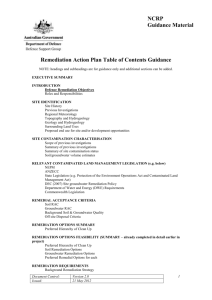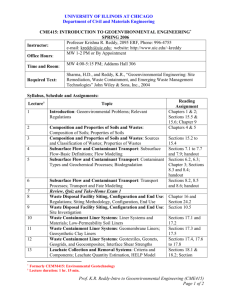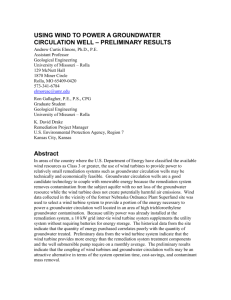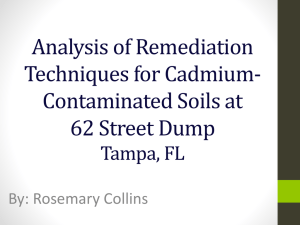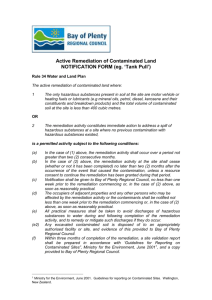Ferrarese - Università degli Studi di Trento
advertisement
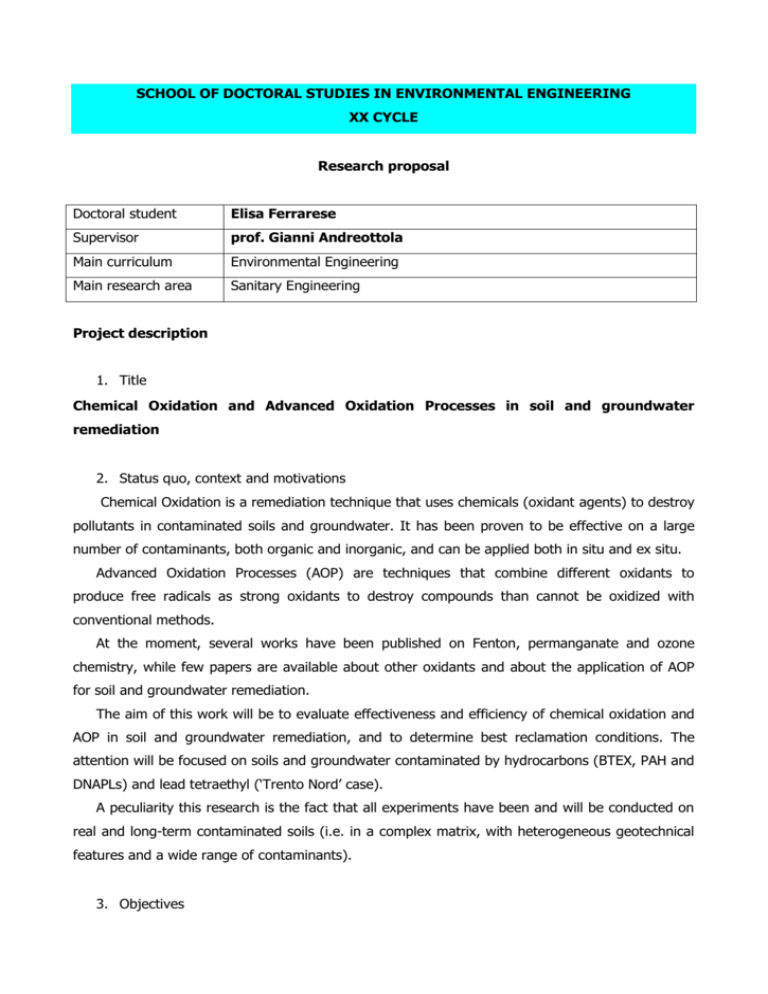
SCHOOL OF DOCTORAL STUDIES IN ENVIRONMENTAL ENGINEERING XX CYCLE Research proposal Doctoral student Elisa Ferrarese Supervisor prof. Gianni Andreottola Main curriculum Environmental Engineering Main research area Sanitary Engineering Project description 1. Title Chemical Oxidation and Advanced Oxidation Processes in soil and groundwater remediation 2. Status quo, context and motivations Chemical Oxidation is a remediation technique that uses chemicals (oxidant agents) to destroy pollutants in contaminated soils and groundwater. It has been proven to be effective on a large number of contaminants, both organic and inorganic, and can be applied both in situ and ex situ. Advanced Oxidation Processes (AOP) are techniques that combine different oxidants to produce free radicals as strong oxidants to destroy compounds than cannot be oxidized with conventional methods. At the moment, several works have been published on Fenton, permanganate and ozone chemistry, while few papers are available about other oxidants and about the application of AOP for soil and groundwater remediation. The aim of this work will be to evaluate effectiveness and efficiency of chemical oxidation and AOP in soil and groundwater remediation, and to determine best reclamation conditions. The attention will be focused on soils and groundwater contaminated by hydrocarbons (BTEX, PAH and DNAPLs) and lead tetraethyl (‘Trento Nord’ case). A peculiarity this research is the fact that all experiments have been and will be conducted on real and long-term contaminated soils (i.e. in a complex matrix, with heterogeneous geotechnical features and a wide range of contaminants). 3. Objectives The main objective of this research is to evaluate the effectiveness of chemical oxidation and AOP in remediation of soil and groundwater contaminated by hydrocarbons (BTEX, PAH, DNAPLs) and lead tetraethyl. Bench scale tests (batch tests and column tests) will be performed in order to: - determine the effectiveness of chemical oxidation (different oxidants and different dosages) and of advanced oxidation processes (combined processes) in destroying organic compounds; - determine oxidant demand, optimal dosages and catalysts requirement; - determine reaction kinetics and reaction times; - determine by-product formation. Pilot scale and full scale tests will be performed and numerical models will be tested in order to determine remediation effectiveness in real conditions and in a complex matrix, as well as to evaluate full scale parameters for in situ applications, such as: - oxidant loading; - injection well spacing (ray of influence); - injection pressure; - injection flow rates; - injection conditions (timing, sequential or simultaneous injection). 4. Development, timing and methodologies of the research My research activity will embrace: - Literature Review (approximately from January 2005 to December 2006): both on theoretical aspects of chemical oxidation and AOP (chemical processes involved, results of laboratory tests) and on in field applications (case studies, guidelines). - Bench scale tests (batch and columns studies) (approximately from January 2005 to December 2006): these tests will be performed on samples of contaminated soil and contaminated groundwater. The aim of oxidation tests is to determine the efficiency of different oxidant agents (e.g. Fenton, permanganate, persulphate, ozone, oxygen) at different dosages and in different media (groundwater, sandy soil, clay-silty soil), reaction kinetics, catalysts optimal dosages and byproducts. Different AOP (e.g. combined processes with ozone with UV and other chemical agents) will also be tested. - Application of numerical models (approximately from June 2006 to December 2007): in order to evaluate the effects of any full scale applications; all results on reaction kinetics and effectiveness inferred from laboratory tests will be applied in numerical models. - Pilot scale tests and field (full scale) tests (approximately from January 2007 to December 2007), in order to evaluate the effectiveness of remediation techniques in real conditions, to determine full scale parameters (such as oxidant demand and best injection conditions), and to compare sample measurements with numerical models outputs. - Data analysis and report of results (approximately from June 2007 to December 2007). In order to complete my research I am going to cooperate with: - Provincia Autonoma di Trento – Progetto Speciale Recupero Ambientale e Urbanistico Aree Industriali, with whom DICA has an agreement for the remediation project of the ‘Trento Nord’ contaminated site, and which will provide samples of contaminated soil and groundwater; - analytical laboratory of Trentino Servizi S.p.A., for chemical analysis and tests; - Hydraulic Constructions and Hydrology Research Group of DICA, for application of available numerical models. The facilities I will need are: - chemical analysis equipment and test tools (GCMS, HPLC, TOC Analyzer, IC, ICP, ozone generator and other instrumentation), which will be provided by Trentino Servizi S.p.A. or by LISA (Laboratorio di Ingegneria Sanitaria Ambientale); - plants for bench scale tests (designed and realized by LISA) and plants for pilot and full scale tests (realized or purchased by LISA); - available 3D models for groundwater flow simulation in complex matrices. Bibliography Brown G.S., Bartonb L.L., Thomson B.M. (2003), Permanganate oxidation of sorbed polycyclic aromatic hydrocarbons. Waste Management, 23 (2003), 737-740. Choi H., Lim H.N., Kim J., Hwang T.M., Kangc J.W. (2002), Transport characteristics of gas phase ozone in unsaturated porous media for in-situ chemical oxidation. Journal of Contaminant Hydrology, 57 (2002), 81-98. Conrad S.H., Glass R.J., Peplinski W.J. (2002), Bench-scale visualization of DNAPL remediation processes in analogue heterogeneous aquifers: surfactant floods and in situ oxidation using permanganate. Journal of Contaminant Hydrology, 58 (2002), 13-49. ITRC, Interstate Technology Regulatory Council (2005), Technical and Regulatory Guidance for In Situ Chemical Oxidation of Contaminated Soil and Groundwater, 2nd Edition. ITRC, ISCO Team. Liang C., Bruell C.J. Marley M.C., Sperry K.L. (2004), Persulfate oxidation for in situ remediation of TCE: I. Activated by ferrous ion with and without a persulfate–thiosulfate redox couple. Chemosphere, 55 (2004), 1213–1223. Persulfate oxidation for in situ remediation of TCE: II. Activated by chelated ferrous ion. Chemosphere, 55 (2004), 1225– 1233. Lim H.N., Choi H., Hwangc T.M., Kangc J.W. (2002), Characterization of ozone decomposition in a soil slurry: kinetics and mechanism. Water Research, 36 (2002), 219229. Kakarla P.K., Andrews T., Greenberg R.S., Zervas D. (2002), Modified Fenton’s Processes for Effective In-Situ Chemical Oxidation – Laboratory and Field Evaluation. Remediation Journal, Volume 12, Autumn (Fall) 2002, 23-36, Wiley Periodicals. Kim J., Choi H. (2002), Modeling in situ ozonation for the remediation of nonvolatile PAHcontaminated unsaturated soils. Journal of Contaminant Hydrology, 55 (2002), 26-285. MacKinnon L.K., Thomson N.R. (2002), Laboratory-scale in situ chemical oxidation of a perchloroethylene pool using permanganate. Journal of Contaminant Hydrology, 56 (2002), 49-74. Masten S.J., Davies S.H.R. (1997), Efficacy of in-situ ozonation for the remediation of PAH contaminated soils. Journal of Contaminant Hydrology, 28 (1997), 327-335. Metcalf & Eddy Inc. (2003), Wastewater Engineering – Treatment and Reuse, Fourth Edition, McGraw Hill. Ohlenbusch G., Hesse S., Frimmel F.H. (1998), Effects of ozone treatment on the soil organic matter on contaminated sites. Chemosphere, 37 (1998), 8, 1557-1569. Shina W.T., Garanzuaya X., Yiacoumia S., Tsourisb C., Gub B., Mahinthakumar G.K. (2004), Kinetics of soil ozonation: an experimental and numerical investigation. Journal of Contaminant Hydrology, 72 (2004), 227-243 U.S. EPA, Unites States Environmental Protection Agency (1998), Field Applications of In Situ Remediation Technologies: Chemical Oxidation. EPA 542-R-98-008, September 1998. Watts R.J., Asce M., Teel A.L. (2005), Chemistry of Modified Fenton’s Reagent (Catalyzed H2O2 Propagations – CHP) for In Situ Soil and Groundwater Remediation. Journal of Environmental Engineering, April 2005, 612-622. Watts R.J., Dilly S.E. (1996), Evaluation of iron catalysts for the Fenton-like remediation of diesel-contaminated soils. Journal of Hazardous Materials, 51 (1996), 209-224. Watts R.J., Haller D.R., Jones A.P., Teel A.L. (2000) , A foundation for the risk-based treatment of gasoline-contaminated soils using modified Fenton's reactions. Journal of Hazardous Materials, Volume 76, 28 (2000), 73-89. Date 03/10/2005 Elisa Ferrarese
